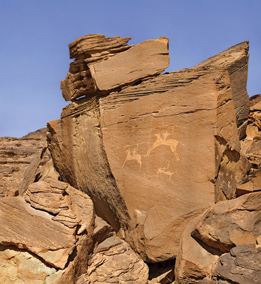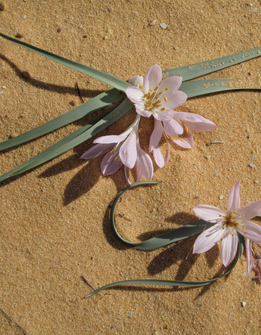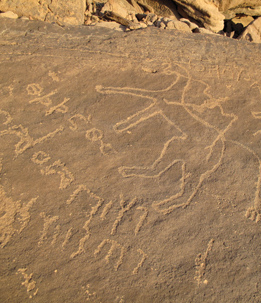 |
||
A complex finding at Graffiti Rocks, near Riyadh, shows lions, ibexes, ostriches, horses, and battle scenes. The date of the drawings are unknown, but probably after 1,500 B.C.E.Photos: Richard T. Bryant |
In Search of the Arabian Horse
Carnegie Museum of Natural History archaeologist Sandra Olsen, one of the world’s leading experts on the human-horse relationship, has taken up a thrilling new quest: finding the origins of one of the world’s most storied animals, the Arabian horse. For zooarchaeologist Sandra Olsen, the black Islamic robe and matching headscarf wasn’t the usual—or the most practical—field attire. Then again, scaling cliffs in the Saudi Arabian desert to capture panoramic images of ancient rock art wasn’t the usual field excursion for the veteran explorer more accustomed to digging up bones in the Eurasian plains.
Petroglyphs of cavalrymen and a camel with ancient Arabic script at the site of Bi'r Hima in the southwestern part of the country.What she found there captivated her: images of horses, extinct animals from Africa, and prehistoric people as depicted in petroglyphs, or rock art, etched into cliff faces throughout the Arabian Peninsula. The ancient murals were created by early hunters and, later, nomadic camel-herders, ancestors to Arabic-speaking Bedouins who still roam the Saudi desert today.
It’s a journey that began several years ago when Olsen was asked to lend her expertise to a major exhibition, A Gift from the Desert: The Art, History and Culture of the Arabian Horse, which she co-curated with art historian Cynthia Culbertson. Showcasing more than 400 pieces of art and artifacts that explore the story of the oldest known breed of riding horse, the exhibition closed in October after a six-month run at The International Museum of the Horse at the Kentucky Horse Park.
Now Olsen is trying to answer questions about what happened to the domesticated horse when it first moved off the Eurasian steppes, making its way down through the Near East, over to Egypt, and into the Arabian Peninsula—and how that winding, arduous journey impacted the course of human history. The royal treatmentThe Arabian horse has long been an enduring symbol of beauty, nobility, and pride worldwide, particularly in Saudi Arabia, where it has played such an important role in the kingdom’s political and religious history. The founder of Saudi Arabia, King Abdul Aziz Al Saud, was the last leader to unite a country on horseback and was a breeder of Arabian horses. The Prophet Muhammed is said to have bequeathed to Muslims a tradition of respect and admiration for the horse, and the principles of horsemanship, or furusiyya, are closely associated with Islamic values of honor, generosity, and chivalry.
Sandra Olsen at Jubbah in northern Saudi Arabia.“The Arabian horse is tied into the spread of Islam and Arabic trade, culture, and knowledge,” Olsen explains. “It’s very important for the dynamics in the Middle East going all the way back to the 15th century B.C.E. The Arabian horse has such a close relationship with humans in that region that you can’t imagine taking the horse out of the history of civilization there.” Horses are not warm-weather creatures by nature, but over time, the Arabian horse evolved to withstand the punishing heat of the desert. Among those adaptations: nostrils that can flare to the size of a teacup, allowing them to take in more oxygen, and thinner necks that cool the air going into their lungs while galloping. Thanks to evolution and special breeding, these hardy animals were able to survive on a sparse diet of camel’s milk and dates. “These horses were originally bred for chariot warfare, so not only did they have to endure the hot and dry environment, but they were also getting a lot of exercise,” Olsen says. “They needed speed, stamina, and the ability to dissipate heat.” These traits persisted over the centuries, even far from the desert, making the Arabian a favorite with equestrians worldwide. Several breeds, including the Thoroughbred, were created using Arabian sires, Olsen notes, and Arabian enthusiasts in the West have included the likes of Catherine the Great, Napoleon Bonaparte, and George Washington. Today, there are more than 440,000 living Arabian horses still prized for their intelligence and endurance. New technique, old questionsIt was a twist of fate that would bring Olsen to Saudi Arabia. While working on the Kentucky exhibition, through the support of the Saudi Arabian Equestrian Federation, Olsen spent three years visiting museums across Europe and the Middle East in search of art, artifacts, and knowledge about the Arabian horse. Along the way, she befriended the country’s Minister of Education, to whom she happened to mention a new robotic imaging technology called GigaPan that was developed by computer scientists at Carnegie Mellon University and NASA. GigaPan is a robotic platform for capturing very high-resolution panoramic images from a standard digital camera. Olsen suggested to the minister that she might use the GigaPan platform to capture images of the petroglyphs that dot the Saudi landscape. She could then study these images in great detail back in Pittsburgh to find out what they might reveal about the treasured Arabian breed. The sandy desert environment means there is little skeletal material preserved in the region, so these petroglyphs are likely the best source of information about the arrival and early uses of horses there. When Olsen embarked on her trip last winter, with support from the Layan Foundation, she was accompanied by her spouse and fellow Carnegie Museums scientist, Chris Beard, along with New Mexico-based photographer Richard T. Bryant, a team of local archaeologists including Majeed Khan, a leading authority on the rock art of Arabia and the Middle East, and an entourage of security guards, police, and guides. “I’ve worked in exotic places all over the world, but this was a whole different kind of adventure.”
-Sandra OlsenThe team visited four petroglyph sites: Shuwaymis and Jubbah in northern Saudi Arabia, Graffiti Rocks in the center, and Bi’r Hima in the south. What they found were elaborate galleries of tens of thousands of images and inscriptions that were either carved or pecked into the sandstone over the course of millennia, including depictions of cheetah, lions, dogs, camels, cattle, horses, goddesses, human figures, geometric shapes, ancient text, and more. Early Neolithic carvings from a climatic “Wet Phase” are deeply pecked into the stone surfaces, but later scenes are lightly scratched through the dark “desert varnish” of manganese and iron salts that coated the stone after the desert became more arid. The earlier examples often show hunting scenes in which men carrying bows are facing wild game. Later petroglyphs, ranging in age from 1,500 B.C.E. to 500 C.E., are dominated by camels, cavalrymen on horseback, and written script. To the untrained eye, the petroglyphs might look like the work of a particularly imaginative child. But to Olsen and her fellow archaeologists, they are sophisticated and esthetically complex evidence of how humankind lived thousands of years ago. Decoding the pastThe group’s days in the field would start before dawn with an hour-long Jeep caravan ride into the desert. “I said, ‘If I’m an honorary male here, I’m also an honorary 17-year-kid,’” Olsen laughs. “We were racing across the dunes at 70 miles per hour, and it was just phenomenal.” A Western female scientist working in a male-dominated country meant a lot of going with the flow. “I knew I had to be more tucked in than usual,” says Olsen. An attempt to eat at Pizza Hut in a city in the south ended up with takeout back at the hotel since there wasn’t a designated family section that allowed women in the restaurant. Although her presence was a novelty, Olsen says she was always treated with respect. She also reserved judgment about the expectations placed on her as a woman in Saudi Arabia, recalling that not so long ago her own foremothers wore long dresses and scarves while establishing their homesteads in her native Kansas. “We have to look at our culture to see how our styles have changed,” she says. “We are just at one point with our wardrobe, and they are at another.”
Drivers and guides, far left, rest near the site of numerous petroglyphs at Bi’r Hima.Back at home at Carnegie Museum of Natural History, sans her abaya and out of the glaring sun, Olsen now has the luxury of time to analyze the hundreds of GigaPan images that Bryant took of the petroglyphs. She hopes to showcase these panoramas—both in murals and in an interactive multimedia display—at Carnegie Museum of Natural History in the near future. For now, a single image from the Jubbah site is on view at the museum through the end of the year, as one of eight images chosen for a juried gallery show held in conjunction with the Fine International Conference on Gigapixel Imagery for Science. In the meantime, Olsen is trying to decode the secrets of the petroglyphs. She knows that after the horse was domesticated on the Eurasian steppes in 3,500 B.C.E., it took another 1,000 years to reach Syria, Iran, and Iraq in the Near East. It’s known that the first horse arrived in Egypt approximately 900 years later. But Olsen explains that, in the ancient art, the horse doesn’t start to look Arabian until around 1,450 B.C.E., when Egyptian Pharaoh Thutmose III obtained them as war booty in chariot warfare against the Hittite people. She believes this may be the turning point after which the early prototypes of the breed, which could live and work in hot, arid climates, began moving into the Arabian Peninsula. One particularly striking image from Olsen’s trip is a chariot depiction at the Jubbah site. Likely dating between 1,800 B.C.E -1,200 B.C.E., it indicates the artist was aware of horses or had spoken to someone else who had seen them. This might be the oldest known evidence of the horse and a two-wheeled vehicle in the Arabian Peninsula. But so much still remains unknown, including when the Arabian horse arrived in the land whose name the breed now bears.
Olsen examines an image of the extinct and enormous long-horned African mammal, Pelorovis, a possible ancestor to domestic cattle or the cape buffalo.The only way to discover more is to keep exploring. That’s why, this winter, Olsen plans a month-long return trip to Saudi Arabia, this time armed with a 3D laser digitizer to capture detail such as texture and depth of the petroglyphs. She’s excited to resume her desert adventure. “I didn’t think I would be doing something like this at this stage of my career, but I’m very fortunate,” she says. “This work has had a tremendous impact on me as a scientist and holds the potential to tell us so much about this important chapter in the history of the human-horse relationship.” Looking a Gift Horse in the Mouth
How a one-of-a-kind donation to Carnegie Museum of Natural History will aid in tracing the origins of the Arabian horse.On a 90-degree day this past June, Sandra Olsen climbed into a 16-foot rental truck and rode nearly 900 miles from Pittsburgh to the Craver farm in central Illinois to pick up the largest collection of Arabian horse skulls in the world. The Carnegie Museum of Natural History curator of anthropology was joined on this unusual road trip by colleague Suzanne McLaren, collection manager of mammals. One by one, Olsen and McLaren dusted off the skulls and carefully packed them in dozens of plastic bins filled with Styrofoam peanuts before loading them onto the truck for proper storage at the museum. It wasn’t easy work in the hot, muggy weather. But for renowned Arabian horse breeder Charles Craver and his wife, Jeanne, the day marked both a beginning and an end. For decades, after the death of their horses, the Cravers have processed the skulls of the animals and stored them in a small building next to their house. It was a tough job, both physically and emotionally. “We didn’t always enjoy harvesting the heads,” the 84-year-old Charles Craver told a Springfield, Ill.-newspaper, The State Journal-Register. “But it seems like a shame to have a thing like that end up in the ground.” Recognizing their potential research value, the Cravers amassed more than 160 Arabian horse skulls over the years, some donated from other breeders, along with detailed information about their lineage. Olsen learned of the Craver skulls through a mutual friend and checked with John Wible, the museum’s curator of mammals, about whether his section would have the space and interest in acquiring this one-of-a-kind collection. The answer was yes. “It’s just such a rare and valuable thing to have for horses or anything else, so we are really very pleased to receive it,” says Olsen, who is now studying the origins of the Arabian breed. Olsen hopes to compare the modern-day Arabian skulls from the Craver farm with bones from the earliest known domesticated horses she found in northern Kazakhstan—and from any archaeological examples of proto-Arabian horses that she can locate from Egypt and the Near East to see where they fit in the evolutionary continuum. “Now when I get skeletal remains,” Olsen says, “I will have a modern-day database for comparison, which is fantastic.”
|
|
Putting the Magic in the Miniature Railroad · The Things They Carried · The Expressionist · Directors' Note · NewsWorthy · Face Time: Marilyn Russell · Science & Nature: A Walk with the Dinosaurs · Artistic License: Finding Joy in the Moment · Field Trip: Oh, the Places They Go · The Big Picture
 |
Copyright © 2017 CARNEGIE Magazine. All rights reserved. |

 I’ve worked in exotic places all over the world, but this was a whole different kind of adventure,” says Olsen, curator and head of anthropology at Carnegie Museum
I’ve worked in exotic places all over the world, but this was a whole different kind of adventure,” says Olsen, curator and head of anthropology at Carnegie Museum  Olsen is counting on the petroglyphs to shed light on the early days of the Arabian horse, a cultural treasure of the modern-day Kingdom of Saudi Arabia and a breed that played a vital role in the Egyptian civilization. Tracing the emergence and spread of the Arabian horse by deciphering these carvings, a project of great interest to the Saudi people, will be the purpose of Olsen’s return trip this winter.
Olsen is counting on the petroglyphs to shed light on the early days of the Arabian horse, a cultural treasure of the modern-day Kingdom of Saudi Arabia and a breed that played a vital role in the Egyptian civilization. Tracing the emergence and spread of the Arabian horse by deciphering these carvings, a project of great interest to the Saudi people, will be the purpose of Olsen’s return trip this winter. Olsen was a natural collaborator, as she’s one of the world’s leading authorities on the role of the horse in prehistory. Her research made headlines in 2009 when she published new evidence suggesting that the Botai, who lived in what are now the plains of northern Kazakhstan some 5,500 years ago, were the earliest known people to possess domesticated horses. She found clues about the lifestyle of these ancient horse herders in bones and pottery shards unearthed from Botai settlements, where she’s worked since 1993.
Olsen was a natural collaborator, as she’s one of the world’s leading authorities on the role of the horse in prehistory. Her research made headlines in 2009 when she published new evidence suggesting that the Botai, who lived in what are now the plains of northern Kazakhstan some 5,500 years ago, were the earliest known people to possess domesticated horses. She found clues about the lifestyle of these ancient horse herders in bones and pottery shards unearthed from Botai settlements, where she’s worked since 1993.

 “The only thing that is absolutely clear is that Arabian horses evolved for chariotry in the hot climate, probably in the 15th century B.C.E.” Olsen says. “But there is still much more to be learned about their origin.”
“The only thing that is absolutely clear is that Arabian horses evolved for chariotry in the hot climate, probably in the 15th century B.C.E.” Olsen says. “But there is still much more to be learned about their origin.”